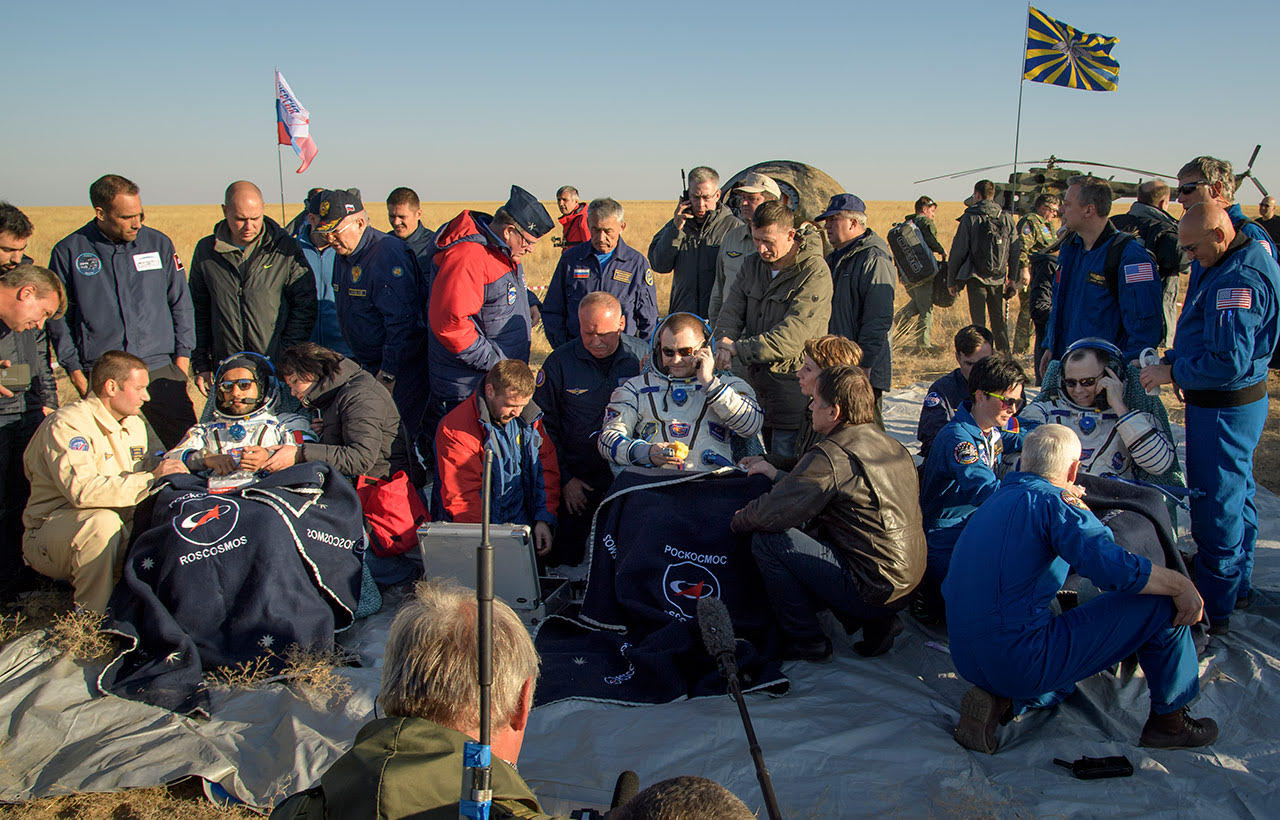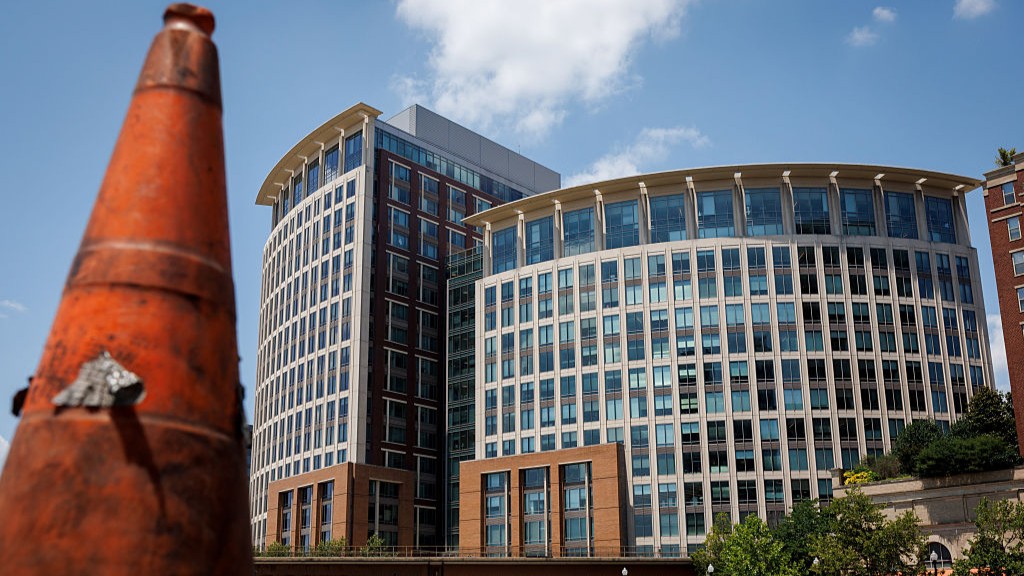First Emirati Astronaut Returns to Earth with Russian-US Space Station Crew
UAE astronaut Hazzaa Ali Almansoori spent 8 days in space.
The first Emirati astronaut has returned to Earth after an eight day mission to the International Space Station, landing with Russian and American crewmates were were in orbit for seven months.
Hazzaa AlMansoori of the United Arab Emirates' (UAE) Mohammed bin Rashid Space Centre (MBRSC) touched down with Aleksey Ovchinin of Roscosmos and Nick Hague of NASA aboard Russia's Soyuz MS-12 spacecraft. Descending under a parachute and slowed by braking thrusters, the capsule landed on the steppe of Kazakhstan, near the town of Dzhezkazgan, at 6:59 a.m. EDT (1059 GMT or 4:59 p.m. local time) on Thursday (Oct. 3).
Met by Russian recovery forces and members of their respective space agencies, Ovchinin, Hague and AlMansoori were helped out of their spacecraft and given brief medical exams as they began adjusting to being back on Earth. The three appeared to be in good health, smiling and talking to family members by phone.
Related: Hazzaa Almansoori: The 1st UAE Astronaut's Space Mission in Photos

The landing brought to a close Ovchinin and Hague's 203-day mission, during which they served on the space station's 59th and 60th expedition crews. The two arrived at the orbiting lab on March 14, 2019, five months after they survived an inflight abort on their first attempt at reaching the station.
AlMansoori, as a spaceflight participant flying under a contract between Russia and the UAE, lifted off with his landing crewmates' replacements, Oleg Skripochka of Roscosmos and Jessica Meir of NASA, on Soyuz MS-15 on Sept. 25. For eight days, he, Skripochka, Meir, Ovchinin and Hague worked together with Expedition 60 crew members Alexander Skvortsov of Roscosmos, Andrew Morgan of NASA and Luca Parmitano of the European Space Agency (ESA).
On Tuesday (Oct. 2), Ovchinin handed over command of the station to Parmitano, a first for an astronaut from Italy.
Breaking space news, the latest updates on rocket launches, skywatching events and more!
"This has been a long and interesting flight," said Ovchinin during a brief televised change of command ceremony. "It has been exciting, it has been a thrill and ride."
Ovchinin, Hague and AlMansoori's departure from the station marked the official end of Expedition 60 and start of Expedition 61. Soyuz MS-12 undocked from the Rassvet module at 3:37 a.m. EDT (0737 GMT).
Three and a half hours later, after a de-orbit burn at 6:06 a.m. EDT (1006 GMT), the Soyuz and its crew were safely on the ground.
AlMansoori logged 7 days, 21 hours and 1 minute circling Earth 128 times on his first spaceflight. A 35-year-old former military pilot, he was selected for the UAE astronaut program from a pool of more than 4,000 applicants. In addition to representing his country, AlMansoori was also the third Arab to fly in space after Prince Sultan bin Salman al-Saud of Saudi Arabia and Muhammed Faris of Syria.
In Photos: The Spacewalking Astronauts of Expedition 60

Hague, 44, has now completed his second spaceflight after reaching the fringes of space on the Soyuz MS-10 abort. A member of NASA's 2013 astronaut class (nicknamed the "8 Balls"), Hague conducted three extravehicular activities (EVAs, or spacewalks) totaling 19 hours and 56 minutes outside the space station.
Ovchinin, 48, completed his third mission to the station (including the MS-10 abort). In 2016, he served as an Expedition 47/48 flight engineer. With more than 374 days in space — including one EVA lasting 6 hours and 1 minute — he now ranks 31st out of the 572 people who have flown in space by total time spent off Earth.
Departing their landing site, Ovchinin, Hague and AlMansoori will be flown by helicopter to the Kazakh town of Karaganda for a welcome ceremony before Ovchinin and AlMansoori leave for Star City, near Moscow, and Hague boards a NASA jet for the Johnson Space Center in Houston.
Soyuz MS-12 was the 58th Soyuz to launch for the International Space Station. It traveled 80.8 million miles (130 million km) completing 3,248 orbits of Earth.
Follow collectSPACE.com on Facebook and on Twitter at @collectSPACE. Copyright 2019 collectSPACE.com. All rights reserved.
- UAE Issues Postage Stamps Honoring First Emirati Astronaut in Space
- The First Emirati Astronaut Is Ready to Launch Into Space
- First Emirati Astronaut to Fly UAE Flag and Tree Seeds to Space Station
Follow Doris Elin Urrutia on Twitter @salazar_elin. Follow us on Twitter @Spacedotcom and on

Join our Space Forums to keep talking space on the latest missions, night sky and more! And if you have a news tip, correction or comment, let us know at: community@space.com.

Robert Pearlman is a space historian, journalist and the founder and editor of collectSPACE.com, a daily news publication and community devoted to space history with a particular focus on how and where space exploration intersects with pop culture. Pearlman is also a contributing writer for Space.com and co-author of "Space Stations: The Art, Science, and Reality of Working in Space” published by Smithsonian Books in 2018.In 2009, he was inducted into the U.S. Space Camp Hall of Fame in Huntsville, Alabama. In 2021, he was honored by the American Astronautical Society with the Ordway Award for Sustained Excellence in Spaceflight History. In 2023, the National Space Club Florida Committee recognized Pearlman with the Kolcum News and Communications Award for excellence in telling the space story along the Space Coast and throughout the world.

